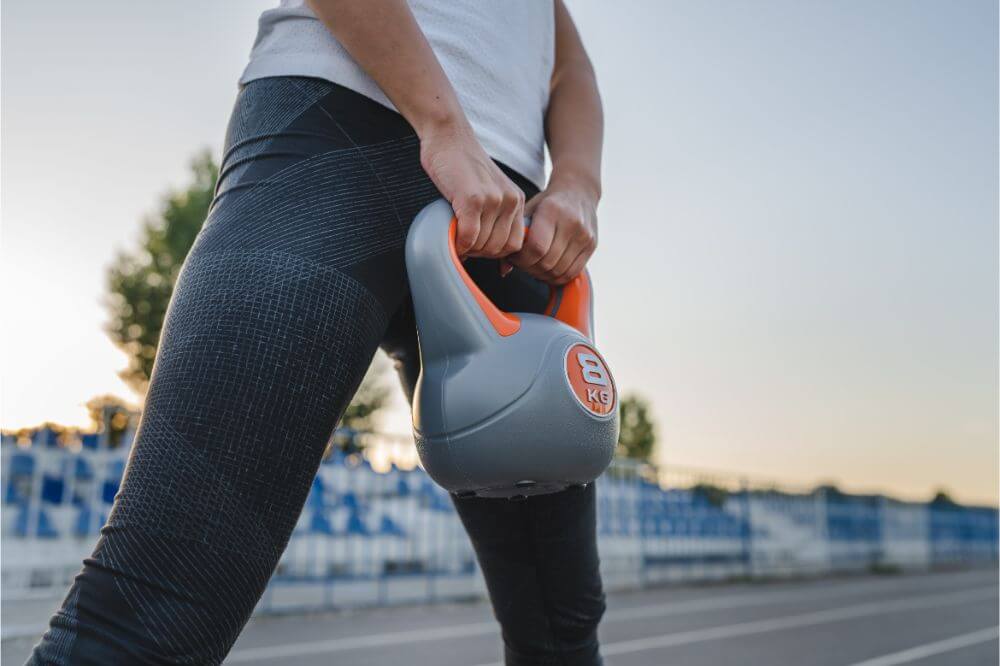Getting started with weight training sounds quite straightforward. You walk into a gym, grab some weights, and start lifting, right? While it may be this simple in theory, the sheer array of different weights available in any gym can make things a tad more complicated.
Should you start with a kettlebell or are free weights more suited to your fitness goals? Read on to learn everything you need to know about the kettlebell vs. free weights debate.
What Are Free Weights?
Even if you’re new to weightlifting, you might have heard the term “free weights” before. As the name suggests, free weights are all those weights that aren’t fixed to another piece of equipment and can be moved around freely. While you’re working against complex mechanisms when using weight machines, the only force you need to conquer in the case of free weights is gravity.
These pieces of equipment are extremely versatile. You can basically use them in whichever way you want. In addition, most free weights are affordable and don’t take up a lot of space. Hence, you don’t need a gym membership to take advantage of them. This makes free weights a useful accessory in anyone’s fitness tool arsenal. Whether they’re aiming to sculpt their body or just want to take their usual cardio routine a step further.
How Do Kettlebells Fit Into This Picture?
When speaking of free weights, most people probably imagine barbells and dumbbells. However, free weights come in several other types. While each may function based on the same idea, they have varying shapes and sizes, making them appropriate for different purposes.
Here are the types of free weights you’ll find at fitness equipment stores:
- dumbbells
- kettlebells
- barbells
- weight plates
- medicine balls
- sandbells
As you can see, kettlebells are a type of free weight. Made from cast-iron, they consist of a single spherical weight with a handle on top. Kettlebells differ from dumbbells not only in appearance but also in weight distribution.
Dumbbells and barbells consist of a bar with two equal-sized weights on each side. The weight is distributed to the two sides of the hand gripping the dumbbell or the two sides of your body when you lift a barbell.
In contrast, when you grip a kettlebell, you’re holding the entire weight directly in your hand, which involves a completely different set of motions.
Kettlebell vs. Free Weights: Differences
Let’s look at what else you need to know in the kettlebell vs. free weights debate.
Weight
Deciding how heavy you should go when you’re new to lifting is no easy task. Going too light will slow your progress, while weights too heavy pose the risk of injury. The appropriate heaviness depends on the type of exercise you’re doing as well.
Each type of free weight comes in lighter and heavier configurations. You can find dumbbells as light as half a pound and up to 50 pounds. There are also adjustable dumbbells that allow you to tweak the weight as you go. This is a practical solution considering that full-body workouts often require a pair of lighter and heavier dumbbells.
Kettlebells start somewhat heavier, with the lightest options weighing 5 pounds. However, female beginners can aim between 13 and 18 pounds when shopping for their first kettlebell.
Weight plates and sandbells range between 2 and 50 pounds, while medicine balls are usually between 2 and 25 pounds. Barbells are in a different league and typically weigh about 45 pounds.
Core exercises work better with lighter weights. For full-body workouts, you might want to look for medium weights. Heavier weights are used for less explosive movements that use the big muscle groups.
Use
Different types of weights have different uses. When choosing between kettlebells and other free weights, the activity you want to undertake will play a decisive role.
Dumbbells are extremely versatile and can add resistance to most exercises. They are typically used for more static parts of a routine. Dumbbells are perfect for joint isolating exercises like bicep curls, shoulder raises, and chest flyers. But you can also use them for more dynamic exercises like lunges.
Adding them to your workout won’t change what you have to do that much. They just add slightly more resistance when body weight exercises are no longer challenging enough to really push your limits.
While dumbbells can be used more dynamically, too, kettlebells are truly what’s designed for these situations. These weights are designed for functional training. They combine strength, flexibility, and cardio all in one. Thanks to their handles, kettlebells are perfect for swinging movements that contribute to core strength, and they’re a solid choice if you want to build endurance, too.
Although they are designed for different purposes, you can often substitute dumbbells for kettlebells and vice versa. This often confuses beginners about which weights they should choose. For instance, it doesn’t matter whether you add dumbbells or kettlebells to your lunges. You can do shoulder presses with kettlebells instead of dumbbells. Sometimes, it comes down to nothing more than personal preference.
Barbells are primarily for bodybuilding, weightlifting, as well as powerlifting, and static exercises like squats. Weight plates can be added to barbells to boost their weight, but they can also be used individually in various exercises, like plate push-ups.
Medicine balls have many uses, but they are primarily for working on your explosive power. Finally, while sandbells may look nothing like weights, these bags combine features of other free weights into one challenging tool. Much like kettlebells and dumbbells, you can add them to your workouts to improve your total body strength.
Kettlebell vs. Free Weights: Pros and Cons
But should you pick up a kettlebell or some other type of free weight instead? Let’s summarize the pros and cons of each option to help you decide.
Kettlebells Pros and Cons
One of the biggest advantages of kettlebells is just how versatile they are. Besides versatility, kettlebells bring something unique to the table. Some exercises are kettlebell-specific and can’t be emulated with other types of weights effectively. Swings and other explosive movements are some examples. In addition, you only need to buy one kettlebell for a full-body workout.
When picking up a new piece of equipment, its ease of use is crucial in how much you will actually use it. Kettlebells are notable contenders in this aspect as well. The handle allows for comfortable gripping.
In terms of disadvantages, kettlebells don’t offer the widest scope in terms of heaviness. If you’re a total beginner, starting with a weight over 10 pounds can be intimidating. Classic dumbbells offer lighter options than dumbbells. Similarly, if you’re lifting seriously, sooner or later, you’ll want to progress to barbells.
Kettlebells also have a learning curve. You might need to contact a professional first to get the most out of these weights.

Other Free Weights Pros and Cons
Dumbbells offer a great introduction to weights with their beginner-friendly sizes. You won’t need too much guidance to incorporate dumbbells into your usual exercises.
Similar to kettlebells, you can use them for many different movements. However, you probably don’t want to restrict yourself to these small tools in the long term – they are rather limiting in their weight. Even though they come in heavier versions, your grip strength will always decide how heavy you can actually go when using dumbbells.
Barbells aren’t exactly accessible as you’ll typically only be able to use them in gyms. They aren’t too beginner-friendly either – you’ll need to seek out a coach to lift them properly. But they are what those interested in weightlifting will need when they are ready to take the next step. Similarly, weight plate exercises are on the more advanced side as well.
Medicine balls have more specific uses than other free weights, so versatility may not be their forte. That said, they can be a great tool for socializing. Tossing a medicine ball is a fantastic way to practice absorbing and redirecting force. Doing this with your gym-mates will boost the social aspect of your workout, which can be a motivating factor.
Sandbells are a relatively new innovation, so they might look a bit confusing at first sight, but their interesting configuration can help improve your grip strength. Additionally, sandbells are safer than traditional weights as they’re softer, so you probably won’t injure yourself if you accidentally drop them.
Kettlebell vs. Free Weights: The Verdict
Kettlebells are a valuable tool for any fitness fanatic. They also bring something new to the table, so they won’t just sit in the corner collecting dust. However, there’s no reason to limit yourself to only one type of weight, as different exercises are best enhanced by different weights.
The key is knowing when to use each one. Add kettlebells to your cardio for a blood-pumping regime, but change to dumbbells when switching focus to isolating exercises.

